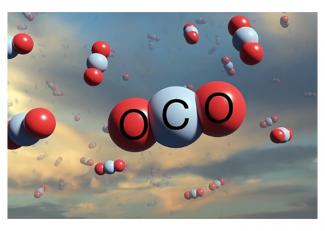In the continuing effort to reach the Administration’s net-zero carbon emission goals in the power sector by 2035 and the broader economy by 2050, NETL is advancing emerging carbon dioxide (CO2) capture research areas such as direct air capture (DAC) and bioenergy with carbon capture and storage (BECCS) by engaging in extramural collaborations with the private sector, academia and other national laboratories.
“DAC with carbon storage and BECCS are both negative emission technologies,” said Krista Hill, federal project manager on the carbon capture team. “This means that carbon dioxide is both removed from the atmosphere and then geologically stored. In DAC, CO2 is pulled directly from the air, whereas BECCS involves the use of biomaterials that naturally remove CO2 during their life cycle and then are burned to generate power in systems equipped with carbon capture and storage.”
NETL aims to reduce the energy consumption and the cost of negative emissions technologies through successful technology development from its external partnerships. To this end, the Lab currently supports 21 active DAC projects through funding opportunity announcements (FOAs) and other funding mechanisms.
For example, four performers selected under a recent FOA titled, Novel Research and Development for the Direct Capture of Carbon Dioxide from the Atmosphere, are field testing DAC systems in relevant environments to optimize the technology and lower costs.
• The Southern States Energy Board is leading efforts to advance a solid amine sorbent-based carbon capture technology developed by Global Thermostat for DAC through field testing at the National Carbon Capture Center in Alabama.
• Electricore is integrating carbon capture technology developed by Svante with DAC technology developed by Climeworks at Wintec Energy’s renewable energy facility in California.
• Global Thermostat is using solid amine sorbents in a field test of a continuous motion DAC system at the Global Thermostat Technology Center in Colorado.
• IWVC is developing a hybrid DAC technology for CO2 capture with simultaneous freshwater production in California.
Also, under this FOA, several project teams are working to develop novel materials for DAC. Research efforts involve tailoring materials to achieve high CO2 capacity at ambient conditions, scalable synthesis, and long operational life at low cost.
• Columbia University is developing an innovative sorbent comprised of trapped amines embedded in porous electrospun fibers that will enable high sorbent stability, and the fiber scaffold will allow for fast exposure of sorbent material to air.
• General Electric Research is developing an advanced integrated reticular sorbent-coated system that integrates pioneering metal-organic framework (MOF) sorbents on an additively manufactured substrate to capture and release atmospheric CO2.
• RTI International is developing two types of advanced adsorbent materials, MOFs and phosphorous dendrimers, incorporated into a low pressure drop monolith-type reactor.
• The University of Kentucky is developing a tailored electrochemical technology with the potential to extract CO2 from ambient air then both regenerate a capture solvent and concentrate CO2 extracted by a membrane.
NETL also funds external projects with other national laboratories. For instance, Oak Ridge National Laboratory is evaluating the feasibility of integrating carbon capture technologies with existing heating, ventilation and air conditioning (HVAC) systems in buildings to remove CO2 directly from ventilated air streams. The use of existing air handling infrastructure can enable the deployment of distributed DAC systems that are modular and scalable.
External NETL-funded efforts to accelerate BECCS technology are also making substantial progress. One example is a demonstration of capture and storage from a concentrated CO2 stream at an ethanol production facility in Illinois. In the project, Archer Daniels Midland Company is capturing CO2 from biofuel production and then storing the CO2 underground in the Mount Simon Sandstone saline reservoir. The cumulative amount of injection into the Mount Simon saline reservoir is over 2 million tonnes of CO2 since the beginning of injection operations in 2017.
“Because DAC and BECCS are emerging technologies, cost and energy consumption are currently barriers to commercialization.” Hill said. “But these NETL-sponsored projects are working to break through those barriers by developing materials and processes that have the potential to offer a viable decarbonization pathway at a cost that attracts industry interest.”
As the cost and energy required to operate these CO2 removal technologies decreases, DAC and BECCS will likely become key facets in reaching a net zero carbon emissions economy. The technologies will be especially important for decarbonizing the industrial sector, as negative emission technologies can help to offset these sectors that are challenging for point source decarbonization. By providing funding and management, NETL is helping to accelerate this process by supporting these projects that align with the goals of the U.S. Department of Energy and the Administration.




